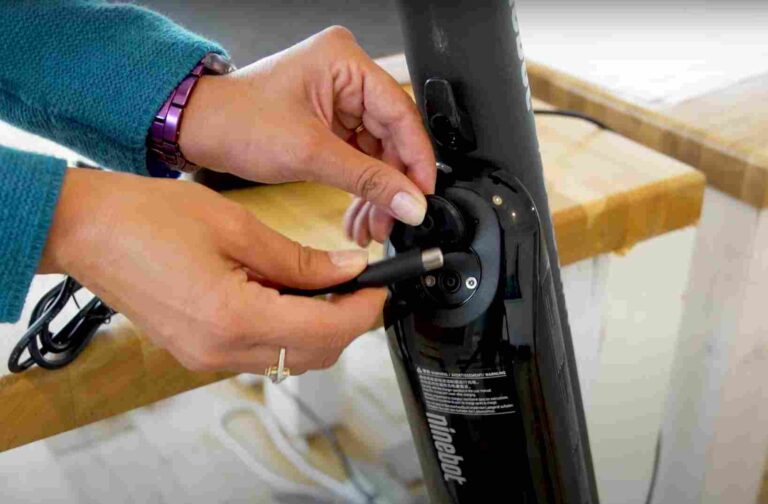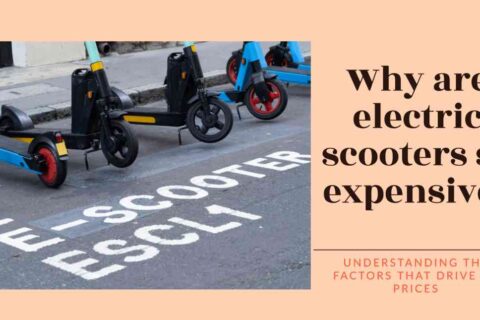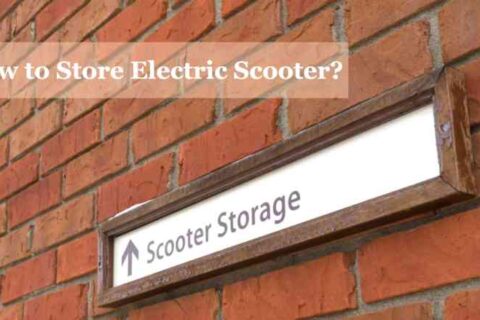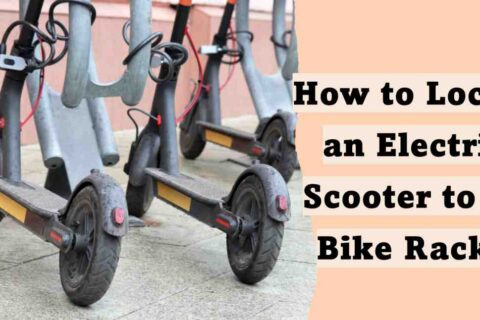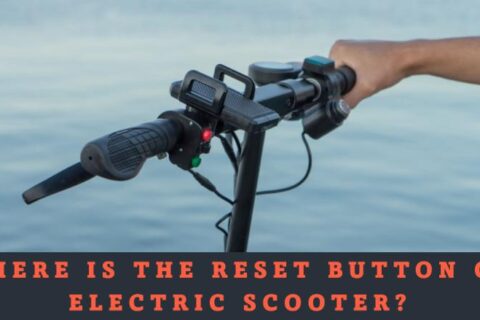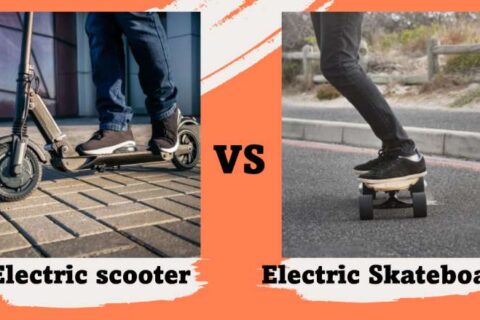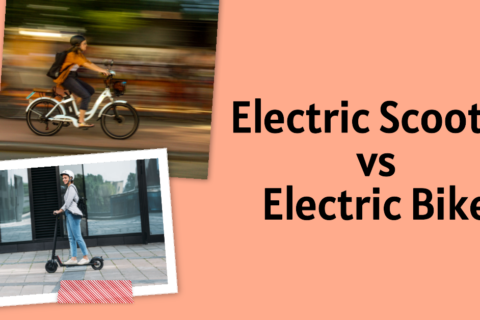Are you in a situation where you need to charge your electric scooter but don’t have a charger? Don’t worry! I’ve got you covered.
In this article, I’ll share 5 practical and easy methods that have been used to charge electric scooters without chargers. All methods are DIY with a very basic level of technical knowledge.
It is always recommended to use the manufacturer charger although in some cases we need alternative options, right? So, let’s explore these handy techniques and discover how to charge electric scooter without charger.
Table of Contents
ToggleAlternative Ways: How to Charge Electric Scooter Without Charger
If you are stuck with a dead scooter battery and no charger, don’t worry. There are alternative ways you can charge your scooter battery without the usual charger. first, start with the essential parameters.
Battery Charging Parameters
Charging electric scooter batteries correctly is essential for optimal performance, longevity, and safety. Different battery types require specific voltage & current parameters to ensure efficient and safe charging.
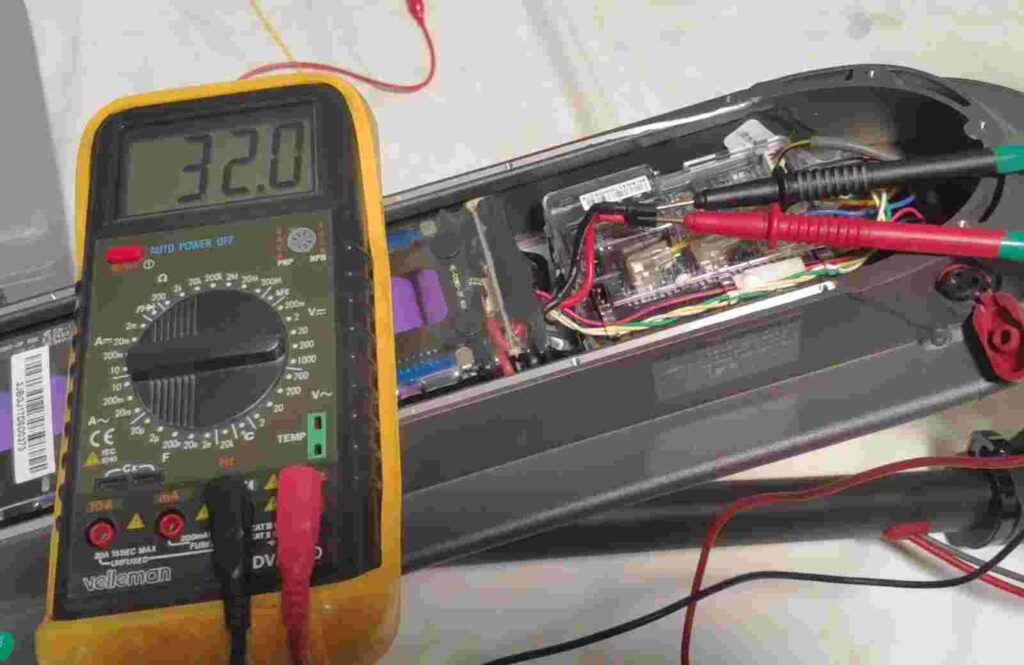
Photo credit: TechTronic9000
Voltage parameters:
Lead-Acid Batteries: Lead-acid batteries used in electric scooters can be charged effectively by setting the voltage based on the number of 2-volt blocks in the battery. To calculate the maximum input voltage, multiply the number of 2-volt blocks by 2.45.
For example, if your lead-acid battery has six 2-volt blocks, the input voltage should be set to a maximum of 6 x 2.45 = 14.7 volts.
Source: Power Sonic.
Lithium-Ion Batteries: Lithium-ion batteries are a popular choice for electric scooters due to their high energy density and long lifespan. When charging a lithium-ion battery, it is crucial to set the voltage to 4.2 volts per cell.
Since lithium-ion batteries are typically composed of multiple cells connected in series, it is important to consider the total number of cells in the battery pack when setting the voltage.
Source: Battery University
Nickel-cadmium or Nickel-Metal Hydride Batteries: Nickel-cadmium (NiCd) or Nickel-Metal Hydride (NiMH) batteries are another type commonly found in electric scooters. To charge those batteries correctly, it is recommended to set the voltage at 1.55 volts per cell.
For example, if your NiMH battery consists of 9 cells, the maximum voltage should be set to 9 x 1.55 = 13.95 volts.
Source: Battery University
Current Parameters
When charging batteries, it is recommended to set the charging current to 20% of the battery’s total capacity. For instance, if the battery has a capacity of 10 Ampere-hours (Ah), the charging current should be set to 2 Amperes (20% of 10 Ah). This helps prevent excessive stress on the battery during the charging process.
The manufacturer manual is the most reliable source of information on the technical data of charging parameters
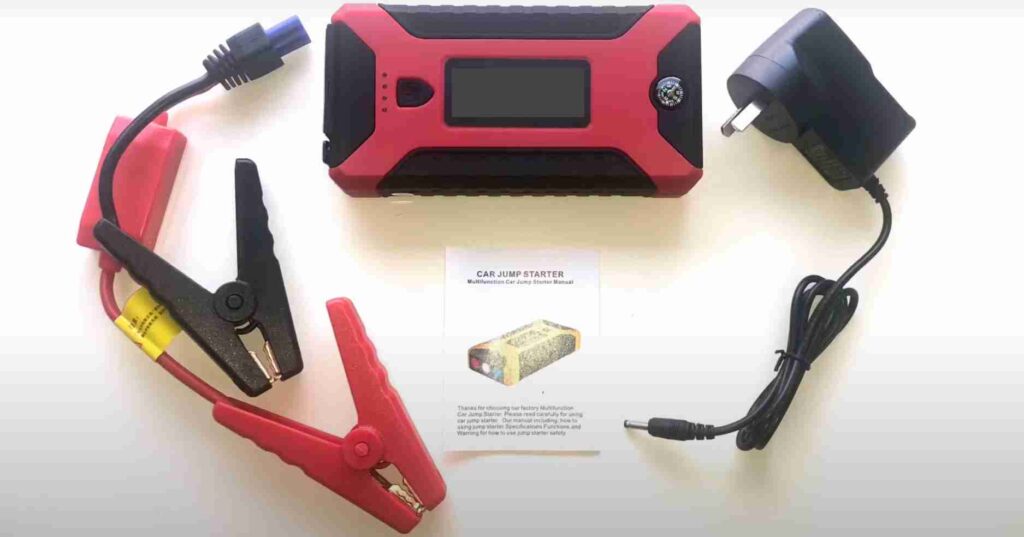
Photo credit: Show-How
Method 1: Using a Portable Car Jumper
Charging your electric scooter without a charger is possible with a portable car jumper.
Step 1: Remove the battery
Locate the battery compartment on your scooter, typically positioned near the floorboard or under the seat. Follow the manufacturer’s instructions to safely remove the battery.
Step 2: Connect the battery to the car jumper
Portable car jumpers are equipped with jumper cables featuring clamps on each end. Connect the positive (+) clamp to the positive terminal (+) of the battery, and the negative (-) clamp to the negative terminal (-). This connection allows the car jumper to supply power to the battery. Scientifically speaking, the car jumper acts as an external power source, providing the necessary electrical potential difference to initiate the charging process.
Step 3: Turn on the car jumper
Switch on the portable car jumper, which delivers a steady charge to the battery. Car jumpers typically provide a constant voltage output, such as 12 volts, which is compatible with electric scooter batteries.
Step 4: Monitor the charging progress
Keep an eye on the battery’s voltage or charge level, if your electric scooter has a built-in indicator. Monitoring the charging progress is crucial to avoid overcharging, as excessive charging can lead to lithium plating and compromise the battery’s performance and longevity.
For example, Lithium-ion batteries operate within a specific voltage range, typically 3.0-4.2 volts per cell, which ensures optimal charging and prevents overcharging.
Step 5: Disconnect the car jumper and reinstall the battery
Once the battery is fully charged, turn off the car jumper and disconnect the clamps from the battery terminals. Take the time to cool it down and then carefully reinstall the battery back into the scooter following the manufacturer’s instructions. Ensure that the battery is securely fastened, as vibrations or movements during scooter use can potentially damage the battery or its connections.

Photo credit: Off-Grid Garage
Method 2: Charging with a Power Supply
Charging your electric scooter using a power supply is a convenient option.
Step 1: Connect the power supply to the facility cable
To start charging your electric scooter, connect the power supply to the facility cable. The facility cable is usually located near the battery compartment or charging port. Ensure a secure connection by plugging in the power supply, making sure it fits snugly.
Step 2: Remove the facility battery
Refer to the scooter’s user manual or manufacturer’s instructions to safely remove the facility battery. Taking precautions is essential to prevent damage or accidental disconnections. Lithium-ion batteries, commonly used in electric scooters, are known for their high energy density and ability to store electrical energy efficiently.
Step 3: Initiate the charging process
Once the power supply is connected and the facility battery is removed, Adjust the voltage output of the variable power supply to match the required charging voltage as per model manual instruction, then turn on the power supply to begin charging. The power supply will deliver the necessary electrical current to recharge the battery.
Step 4: Safely unplug the power supply
When the battery is fully charged, it’s important to follow safety measures while disconnecting the power supply. Turn off the power supply before unplugging it from the facility cable. Carefully remove the plug from the facility cable, avoiding any excessive pulling or tugging that may cause damage.

Photo credit: Testing Everything
Method 3: Charging with Solar Panels
Charging your electric scooter with solar panels is a sustainable and eco-friendly option.
Step 1: Set up the solar panel
To begin, find a sunny spot and position the solar panel there. Make sure it is securely mounted or placed on a stable surface. Connect the solar panel’s output cables to your electric scooter’s charging port or battery terminals.
Step 2: use a charge controller
To prevent overcharging and potential damage to the battery, it’s recommended to incorporate a charge controller into your solar charging setup. A charge controller regulates the flow of electrical energy from the solar panel to the battery, ensuring a safe and optimal charging process.
Step 3: Allow solar charging
Set the solar panels in shade free area so the solar panel could absorb sunlight and convert it into electrical energy to charge the battery. The charge controller will monitor and control the charging process, protecting the battery from overcharging. Remember to leave it connected for a sufficient duration to ensure adequate charging.
Step 4: Disconnect and store the solar panel
When the battery is charged or you no longer require solar charging, safely disconnect the solar panel from your electric scooter. Follow the proper procedure to avoid any potential damage or electrical hazards

Method 4: Utilizing a Universal Power Adapter
Charging your electric scooter with a universal power adapter is a practical and versatile solution when the original charger is unavailable.
Step 1: Plug the power adapter into the electric scooter
Begin by connecting the universal power adapter to the charging port of your electric scooter. Scientifically, electric scooters typically operate on DC (direct current) power.
The power adapter converts the AC (alternating current) power from the electrical outlet into the required DC power, suitable for charging the scooter’s battery.
Step 2: Set the voltage and current
Adjust the voltage and current settings on the power adapter based on your scooter’s specifications as per the manufacturer’s guidelines or set as described in the battery parameter section above.
Step 3: Start the charging process
Once the voltage and current settings are correctly configured, turn on the power adapter to initiate the charging process.
Step 4: Disconnect the power adapter
Once the battery is fully charged or when charging is no longer required, safely disconnect the power adapter from the electric scooter. Following the proper procedure prevents any potential electrical hazards.

Photo credit: RoadRunner Scooters
Method 5: Using Multiple Batteries
When you don’t have a charger for your electric scooter, utilizing multiple batteries can be a practical solution. By having extra batteries on hand, you can easily swap out discharged ones with fully charged ones, ensuring uninterrupted scooter usage.
Step 1: Identify compatible batteries
To begin, make sure you have compatible batteries for your electric scooter. For example, if your scooter requires a 36V battery with a capacity of 10Ah, check the user manual or manufacturer’s guidelines to find batteries that meet these specifications.
Step 2: Swap out the discharged battery
Identify the battery that needs charging and safely remove it from your electric scooter following the user manual’s instructions. Take precautions to handle the battery properly to prevent damage or injury. Replace the discharged battery with a fully charged one, ensuring a secure connection and proper alignment to avoid electrical issues.
Step 3: Repeat the process if needed
If a single fully charged battery doesn’t meet your scooter’s power requirements, repeat the battery swap process. Remove the discharged battery and replace it with another fully charged one.
Continue this cycle as needed until you’ve sufficiently charged the scooter’s battery or utilized all the available fully charged batteries.
Precautions
You have to understand the importance of safely charging scooter batteries without a charger. Here are some valuable tips and precautions to ensure How to Charge Electric Scooter Without Charger:
Wear Safety Gloves and Eye Protection:
When handling batteries and cables, always prioritize your safety. Wear protective gloves to shield your hands from potential exposure to battery acid or any leaks that may occur during charging. Additionally, consider wearing goggles to protect your eyes from any harmful substances.
Battery acid can be harmful if it comes into contact with your skin or eyes
Avoid Overcharging:
While charging your scooter battery using alternative methods is cost-effective, it’s crucial to avoid overcharging.
Overcharging can lead to battery damage or even explosions, posing serious risks. To prevent this, ensure you use the appropriate power level for your specific battery.
Regularly Check the Voltage Level:
During the charging process, regularly checking the voltage level of the battery is essential. By using a multimeter tool, you can monitor the voltage every 10-15 minutes.
If you notice any significant changes or if the voltage exceeds 12 volts, it’s crucial to stop charging immediately to avoid potential damage.
Consider Using a Charging Monitor:
For added safety and peace of mind, you can use a charging monitor. These devices detect when the battery reaches its full charge and automatically cut off the power supply to prevent overcharging.
While not essential for everyone, a charging monitor can be a valuable tool to ensure safe charging.
Safety Tips
When charging scooter batteries without chargers, it’s important to follow certain tips to ensure safety and proper charging. Here are some valuable tips to keep in mind:
- Check Battery Condition: Before charging, inspect the battery for any signs of damage, leaks, or swelling. Do not attempt to charge a damaged or faulty battery, as it can be hazardous.
- Charge in a Well-Ventilated Area: It’s recommended to charge the scooter batteries in a well-ventilated area to prevent the build-up of gases during the charging process. Avoid charging in enclosed spaces or near flammable materials.
- Follow Charging Time Guidelines: Adhere to the recommended charging time provided by the battery manufacturer or the scooter’s user manual. Overcharging or leaving the battery connected for an extended period can result in damage to the battery or reduce its lifespan.
- Avoid Overheating: Monitor the temperature of the batteries during charging. If you notice excessive heat, disconnect the charging source immediately. Overheating can indicate a problem with the battery or the charging process and should be addressed to prevent any safety hazards.
- Use Correct Voltage and Current: Ensure that the charging method you choose provides the appropriate voltage and current for your scooter’s battery. Using incorrect settings can damage the battery or cause it to malfunction.
- Never Leave Unattended: Do not leave the batteries unattended while charging in alternating methods. Regularly check the charging progress and monitor for any irregularities or signs of overheating.
- Keep Away from Water: Keep the batteries and charging equipment away from wet surfaces. Exposure to moisture can damage the batteries and pose a risk of electrical shock.
- Follow Manufacturer’s Guidelines: Always refer to the manufacturer’s instructions and guidelines for charging the scooter batteries. Each scooter model and battery type may have specific requirements that should be followed for safe and optimal charging.
By following these tips and precautions, you can safely charge your scooter batteries without a charger and ensure the longevity and efficiency of your electric scooter.
If all alternative charging methods fail for your electric scooter battery, it may be necessary for an electric scooter battery replacement. Using a damaged or faulty battery can compromise scooter performance and safety.
Final Words
Incorporating factual information and drawing from practical experience, we have developed a comprehensive guide on how to charge an electric scooter without a charger using various alternative methods. By exploring options such as using a portable car jumper, a power supply, solar panels, a universal power adapter, or multiple batteries, you can ensure continuous usage of your scooter, even when a traditional charger is not readily accessible.
Step-by-step guides, practical tips, and important safety precautions will help you to charge your scooter batteries without a charger successfully. It is essential to prioritize safety by wearing protective gloves and eye gear when handling batteries and cables, as battery acid can be hazardous.
Frequently Asked Question (FAQ)
How much watt is required to charge an electric scooter?
The wattage required to charge an electric scooter may vary but typically falls between 60W and 150W. However, it’s a must to consult the scooter user manual or manufacturer’s specifications for the exact wattage requirement.
What is the battery life of electric scooter?
Electric scooter batteries typically last between 2 and 3 years but can last anywhere from a few months to 5 years. A battery may need to be replaced when its performance starts to degrade, which can happen after 150 charge cycles usually.
What can you use to charge an electric scooter?
Charge your electric scooter using the standard charger, a portable charger or power bank, a solar charger, or multiple compatible batteries. Refer to the manual for instructions.
Can one charge a bike battery using an inverter?
No, Inverter intended for larger batteries can cause permanent damage to the scooter’s battery. Inverters are designed for batteries with capacities of 110–220 AH, while scooter batteries typically have capacities of 7AH for smaller scooters and 10AH for larger ones.
How many hours electric scooter battery last?
Electric scooter battery life varies based on factors like model, battery capacity, and usage. It typically lasts 1-4 hours. Range varies too, averaging 10-40 miles on a full charge. Some high-duty electric scooters can last a full day depending on usage.

